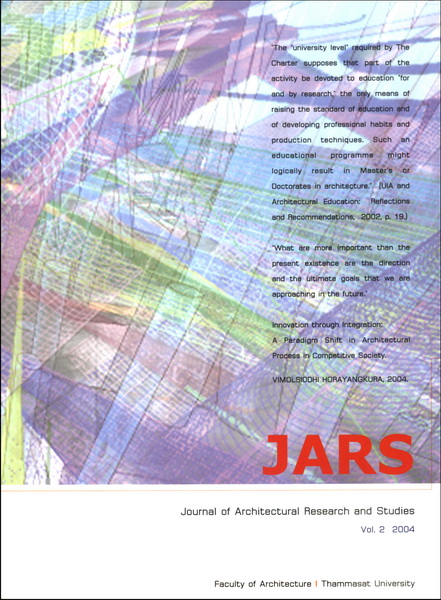Innovation through Integration: A Paradigm Shift in Architectural Process in Competitive Society
Main Article Content
Abstract
The paradigm shift in architecture education, from emphases on formal aesthetics to contextual considerations, especially those related to technological and managerial factors, has essentially led to integration in architectural process, which eventually generates innovation in the creation of architecture. The essences of this keynote presentation are on the following 7 integrative approaches: 1) Integration of multiple disciplines. 2) Coordination of research and design: Design-Research. 3) Toward interdisciplinary approaches among related fields of architecture. 4) Professional internship as a component of architectural education system. 5) Cooperation between academic and professional development. 6) Architectural undertakings in conjunction with the strategies of national development. 7) Integrative knowledge management. More specifically, the integration focuses on academic disciplines, methods and experiences, that are related to architectural creativity. Such integration may be envisioned as the 5th dimension that brings about innovations aspired in this highly competitive society.
Downloads
Article Details

This work is licensed under a Creative Commons Attribution-NonCommercial-NoDerivatives 4.0 International License.
All material is licensed under the terms of the Creative Commons Attribution 4.0 International (CC-BY-NC-ND 4.0) License, unless otherwise stated. As such, authors are free to share, copy, and redistribute the material in any medium or format. The authors must give appropriate credit, provide a link to the license, and indicate if changes were made. The authors may do so in any reasonable manner, but not in any way that suggests the licensor endorses you or your use. The authors may not use the material for commercial purposes. If the authors remix, transform, or build upon the material, they may not distribute the modified material, unless permission is obtained from JARS. Final, accepted versions of the paper may be posted on third party repositories, provided appropriate acknowledgement to the original source is clearly noted.
References
อ่านสมาคมสถาปนิกสยามในพระราชูปถัมภ์ และโครงการจัดการศึกษาสาขาวิชาสถาปัตยกรรม มหาวิทยาลัยธรรมศาสตร์. รายงานการสัมมนา การขยายบทบาทของสถาปนิกไทย (Expanding Thai Architects’ Roles). จัดโดยสมาคมสถาปนิกสยามฯ ร่วมกับโครงการจัดการศึกษาสาขาวิชาสถาปัตยกรรม วันที่ 3 มีนาคม 2542 ณ ห้องประชุมใหญ่ อาคารสมาคมสถาปนิกสยามฯ. ปทุมธานี: โครงการจัดการศึกษาสาขาวิชาสถาปัตยกรรม มหาวิทยาลัยธรรมศาสตร์ ศูนย์รังสิต, 2544.
Juan Enriquez. As the Future Catches You เมื่ออนาคตไล่ล่าคุณ. แปลโดย ชวนิต ศิวะเกื้อ และสมสกลุ เผ่าจินดา. กรุงเทพฯ: เนชั่นนบุ๊คส์ อินเตอร์เนชั่นแน, 2546, หน้า 14 – 24.
วิมลสิทธิ์ หรยางกูร. การพินิจพิเคราะห์กระบวนการ สถาปัตยกรรม: จากอดีตสู่ปัจจุบันและอนาคต (Digesting the Architectural Process: From Past to Present and Future). เอกสารบทความเสนอในการอภิปรายเรื่อง สถาปัตยกรรม ในปัจจุบัน ในการสัมมนา เรื่อง สถาปัตยกรรมอดีต ปัจจุบัน อนาคต จัดโดยสำนักศิลปกรรม ราชบัณฑิตยสถาน วันที่ 25 ่ฃเมษายน 2546 ณ ห้องประชุม โรงแรมรอยัลซิตี้ กรุงเทพฯ, หน้า 2.
อ่านความสัมพันธ์ระหว่างงานออกแบบและงานวิจัยใน วิมลสิทธิ์ หรยางกูร. งานออกแบบเป็นงานวิจัยได้หรือ? (Can Design be Considered as Research). วารสารวิธีวิทยาการวิจัย ปีที่ 15 ฉบับที่ 2 (พฤษภาคม – สิงหาคม 2545) หน้า 167 – 183.
รพิฑตย์ สวรรณะชฎ. การวิจัยทางการออกแบบสถาปัตยกรรม (Research in Designing Architecture). อาษา 04: 06-05: 46, เมษายน – พฤษภาคม 2546, หน้า 102 – 110.
The UIA Architectural Education Commission. UIA and Architectural Education: Reflections and Recommendations. Paris: International Union of Architects (UIA), 2002, pp. 17 – 19, อ้างหน้า 19. UNESCO/UIA Charter for Architectural Education. Approved by XX UIA General Assembly, Barcelona, July 1996.
ทบวงมหาวิทยาลัย. รวมพลังผลักดันสหกิจศึกษาเพื่อพัฒนาประเทศ. เอกสารประกอบการประชุมสัมมนา รวมพลัง ผลักดัน สหกิจศึกษาเพื่อพัฒนาประเทศ. จัดโดยทบวงมหาวิทยาลัย วันที่ 28 สิงหาคม 2545 ณ โรงแรมแอมบาสเดอร์ กรุงเทพฯ, หน้า 1 – 5.
คณะกรรมการเอกลักษณ์ของชาติ สำนักนายกรัฐมนตรี. ประกาศคณะอนุกรรมการดำเนินการจัดประกวดภาพสัญลักษณ์ ประจำชาติไทย “ดอกราชพฤกษ์” และ “ศาลาไทย” ทั้งนี้ เป็นไปตามมติคณะรัฐมนตรี เมื่อวันที่ 2 ตุลาคม 2544 ที่เห็นชอบให้มี การกำหนดสัญลักษณ์ประจำชาติไทย 3 สิ่ง ตามที่คณะกรรมการเอกลักษณ์ของชาติ เสนอ ประกอบด้วย “ช้างไทย” “ดอกราชพฤกษ์” และ “ศาลาไทย” เป็นสัตว์ ดอกไม้ และสถาปัตยกรรมประจำชาติตามลำดับ
Juan Enriquez. เรื่องเดียวกัน, หน้า 24.
The UIA Architectural Education Commission. เรื่องเดียวกัน, หน้า 26.
Francis Duffy. Architectural Knowledge: The Idea of a Profession. London: E&FN Spon, pp. 135 – 142.
Kim Sbarcea (ED.). Rethinking Knowledge. Sydney: Lexis Nexis Butterworths. 2002, pp. 1 – 6.
อ่านแนวทางบูรณาการการเรียนการสอนสถาปัตยกรรมในคณะสถาปัตยกรรมศาสตร์ มหาวิทยาลัยธรรมศาสตร์. รายงาน การสัมมนาพัฒนาการเรียนการสอน และหลักสูตร: แนวทางการบูรณาการในการเรียนการสอนสถาปัตยกรรม. ใน Seminar Report 2002. ปทุมธานี: คณะสถาปัตยกรรมศาสต์ มหาวิทยาลัยธรรมศาสตร์, 2546, หน้า 21 – 50.
อ่านประเด็นข้อผิดพลาดของข้อมูลและข่าวสาร เกี่ยวกับธุรกิจอสังหาริมทรัพย์ และเศรษฐศาสตร์มหภาค ที่มีผลกระทบเชิงลบต่อเศรษฐกิจไทยใน ประศาสน์ ตั้งมติธรรม. 100 วิสัยเท็จพังเศรษฐกิจไทย. กรุงเทพฯ: เคล็ดไทย, 2546.


